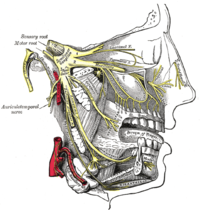
Photo from wikipedia
Neuromodulatory approaches have enlarged the therapeutic armamentarium for the treatment of primary headaches such as migraine and cluster headache. While invasive devices are mainly used in patients with refractory and… Click to show full abstract
Neuromodulatory approaches have enlarged the therapeutic armamentarium for the treatment of primary headaches such as migraine and cluster headache. While invasive devices are mainly used in patients with refractory and chronic conditions, non-invasive approaches are increasingly used in less severely affected patients with episodic headaches. This article critically reviews the literature focussing on recent controlled studies, provides recommendations on their use in clinical practice and strives to integrate them into present treatment regimes. As a relevant drawback, the number of controlled studies is limited with small cohorts included and marked methodological constraints, which hampers any direct comparison with pharmacological approaches.
Journal Title: Schmerz
Year Published: 2019
Link to full text (if available)
Share on Social Media: Sign Up to like & get
recommendations!